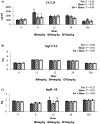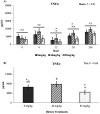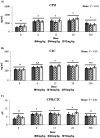Influence of dietary Saccharomyces cerevisiae fermentation product on markers of inflammation and cartilage metabolism in young exercising horses challenged with intra-articular lipopolysaccharide
- PMID: 40336821
- PMCID: PMC12057563
- DOI: 10.1093/tas/txaf042
Influence of dietary Saccharomyces cerevisiae fermentation product on markers of inflammation and cartilage metabolism in young exercising horses challenged with intra-articular lipopolysaccharide
Abstract
The objective was to evaluate dietary Saccharomyces cerevisiae fermentation product (SCFP) on joint inflammation and cartilage metabolism in exercising yearlings challenged with intra-articular lipopolysaccharide (LPS), hypothesizing dietary SCFP (TruEquine®C, Diamond V Mills, Inc.) would ameliorate joint inflammation and increase cartilage metabolism. Thirty Quarter Horse yearlings were stratified by bodyweight (BW), age, sex, and randomly assigned to dietary treatments (n = 10/treatment): control (0), 46, or 92 mg/kg BW/d SCFP. Treatments were top-dressed to 1% BW/d concentrate void of added microbials. Horses were stalled (3.6 m × 7.3 m), offered ad libitum Coastal bermudagrass hay, and exercised 30 min/d, 5 d/wk. On days 0, 21, 42, and 56, wither height, hip height, heart girth, body length, body condition scores (BCS), and BW were recorded. On day 46, one radial carpal joint received 0.8 mL of a 0.5 ng LPS solution or sterile lactated Ringer's solution (LRS) in the contralateral joint. Synovial fluid was collected pre- (0) and 6, 12, 24, and 336 hours post-injection and analyzed for prostaglandin E2 (PGE2), carboxypropeptide of type II collagen (CPII), and collagenase cleavage neopeptide (C2C) via commercial ELISA, and chemokines (CCL2, and CCL11) and cytokines (TNF and IL-10) via multiplex platform. Rectal temperature (RT), heart rate (HR), respiration rate (RR), and carpal circumference (CC) were recorded prior to arthrocentesis. Data were analyzed using PROC MIXED of SAS. By day 56, growth parameters increased (P < 0.01), BCS did not change (P = 0.39), and BW had a treatment × d interaction (P = 0.02) where control tended to be heavier than 92 mg/kg BW on day 56 (P = 0.07). Clinical parameters (RT, HR, RR, CC) were uninfluenced by diet (P ≥ 0.29) but varied over time (P ≤ 0.03). Treatments did not influence cartilage metabolism (CPII, C2C, and CPII:C2C) (P ≥ 0.46) or logPGE2, logCCL2, CCL11, or logIL-10 (P ≥ 0.23). There was a treatment × h interaction for CCL11 (P = 0.04) where control was greater than SCFP groups at h 6. LogIL-10 had a treatment × h interaction where 46 mg/kg BW was lower than control and 92 mg/kg BW at h 12 (P = 0.05). There was a main effect of treatment for TNF (P = 0.04) where 92 mg/kg BW was lower than 46 mg/kg BW and tended to be lower than control. Results indicate that SCFP didn't influence cartilage metabolism or PGE2, though SCFP may ameliorate inflammatory cytokines and chemokines following an acute, intra-articular insult.
Keywords: Saccharomyces cerevisiae; cartilage; equine; lipopolysaccharide; synovial.
© The Author(s) 2025. Published by Oxford University Press on behalf of the American Society of Animal Science.
Conflict of interest statement
The authors acknowledge that they were free from influence by any funding sources or their employees that would result in any conflict of interest.
Figures





References
-
- Baccarin, R. Y. A., Seidel S. R. T., Michelacci Y. M., Tokawa P. K. A., and Oliveira T. M... 2022. Osteoarthritis: a common disease that should be avoided in the athletic horse’s life. Anim. Front. 12:25–36. doi: https://doi.org/10.1093/af/vfac026 - DOI - PMC - PubMed
-
- Bakker, M. F., Verstappen S. M., Welsing P. M., Jacobs J. W., Jahangier Z. N., Van Der Veen M. J., Bijlsma J. W., and Lafeber F. P.; Utrecht Arthritis Cohort study group. 2011. The relation between cartilage biomarkers (C2C, C1,2C, CS846, and CPII) and the long-term outcome of rheumatoid arthritis patients within the CAMERA trial. Arthritis Res. Ther. 13:R70. doi: https://doi.org/10.1186/ar3331 - DOI - PMC - PubMed
-
- Barsig, J., Küsters S., Vogt K., Volk H. -D., Tiegs G., and Wendel A... 1995. Lipopolysaccharide-induced interleukin-10 in mice: role of endogenous tumor necrosis factor-α. Eur. J. Immunol. 25:2888–2893. doi: https://doi.org/10.1002/eji.1830251027 - DOI - PubMed
-
- Bertone, A. L., Palmer J. L., and Jones J... 2001. Synovial fluid cytokines and eicosanoids as markers of joint disease in horses. Vet. Surg. 30:528–538. doi: https://doi.org/10.1053/jvet.2001.28430 - DOI - PubMed
-
- Billinghurst, R. C., Brama P. A. J., Van Weeren P. R., Knowlton M. S., and McIlwraith C. W... 2003. Significant exercise-related changes in the serum levels of two biomarkers of collagen metabolism in young horses. Osteoarthritis Cartilage. 11:760–769. doi: https://doi.org/10.1016/s1063-4584(03)00152-3 - DOI - PubMed
LinkOut - more resources
Full Text Sources
